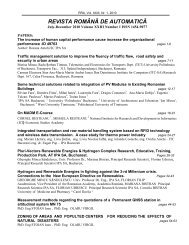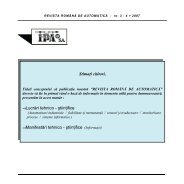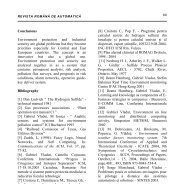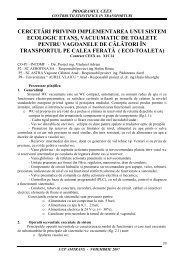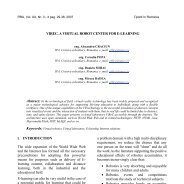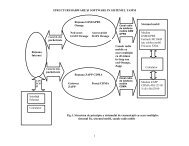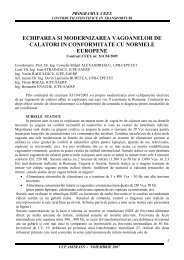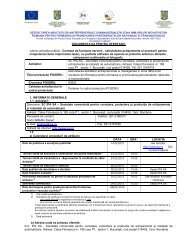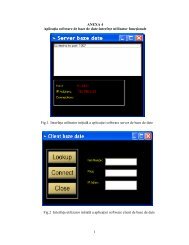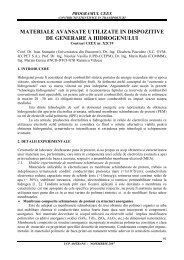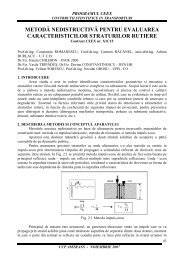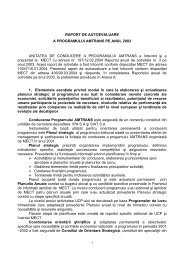REVISTA ROMÃNÄ DE AUTOMATICÄ - IPA SA
REVISTA ROMÃNÄ DE AUTOMATICÄ - IPA SA
REVISTA ROMÃNÄ DE AUTOMATICÄ - IPA SA
Create successful ePaper yourself
Turn your PDF publications into a flip-book with our unique Google optimized e-Paper software.
<strong>REVISTA</strong> ROMÂNĂ <strong>DE</strong> AUTOMATICĂ<br />
15<br />
Taxonomies and documents with mixed<br />
vocabularies [1] In this stage, data can be<br />
composed from multiple domains and<br />
accurately classified in a hierarchical<br />
taxonomy. In fact, the classification can be<br />
used for discovery of data. Simple<br />
relationships between categories in the<br />
taxonomy can be used to relate and thus<br />
combine data. Thus, data is now smart<br />
enough to be easily discovered and sensibly<br />
combined with other data.<br />
Ontologies and rules [1] In this stage, new<br />
data can be inferred from existing data by<br />
following logical rules.<br />
In essence, data is now smart enough to be<br />
described with concrete relationships, and<br />
sophisticated formalisms where logical<br />
calculations can be made on this "semantic<br />
algebra." This allows the combination and<br />
recombination of data at a more atomic level and<br />
very fine-grained analysis of data. Thus, in this<br />
stage, data no longer exists as a blob but as a part<br />
of a sophisticated microcosm. An example of<br />
this data sophistication is the automatic<br />
translation of a document in one domain to the<br />
equivalent (or as close as possible) document in<br />
another domain. Now, can compose a new<br />
definition of the Semantic Web:<br />
a machine-processable web of smart data[1].<br />
Furthermore, we can further define smart data<br />
as data that is application-independent,<br />
composeable, classified, and part of a larger<br />
information ecosystem (ontology).<br />
III. BENEFITS OF THE SEMANTIC<br />
WEB TO THE WORLD WI<strong>DE</strong> WEB<br />
The World Wide Web is the biggest<br />
repository of information ever created, with<br />
growing contents in various languages and<br />
fields of knowledge. But, in the long run, it is<br />
extremely difficult to make sense of this<br />
content. Search engines might help you find<br />
content containing specific words, but that<br />
content might not be exactly what you want.<br />
What is lacking? The search is based on the<br />
contents of pages and not the semantic<br />
meaning of the page's contents or information<br />
about the page.<br />
Once the Semantic Web exists, it can provide<br />
the ability to tag all content on the Web,<br />
describe what each piece of information is<br />
about and give semantic meaning to the<br />
content item. Thus, search engines become<br />
more effective than they are now, and users<br />
can find the precise information they are<br />
hunting. Organizations that provide various<br />
services can tag those services with meaning;<br />
using Web-based software agents, you can<br />
dynamically find these services on the fly and<br />
use them to your benefit or in collaboration<br />
with other services.<br />
IV. WEB OF TRUST<br />
Web is a collaborative medium that enables<br />
the individuals to contribute, access, and<br />
share contents. To further assist users to<br />
contribute more and to increase cooperation,<br />
W3C aims to develop a “Web of Trust”.<br />
Initiatives like Friend of a Friend (FOAF),<br />
RDF and XML signatures, etc, espouse the<br />
aim to achieve Web of Trust. Recently trust<br />
has been recognized as one of the main<br />
factors affecting electronic commerce.<br />
Information regarding a product, physical or<br />
online business acquired from either the user’s<br />
physical, or the online trusted social network<br />
impacts the user’s initial and subsequent levels<br />
of trust in an online business. The impact is<br />
directly associated with the user’s level of trust<br />
in the information source, in terms of source’s<br />
credibility, honesty and ability.<br />
V. WEB 2.0<br />
Web 2.0 is a trend in World Wide Web<br />
technology, and web design, a second<br />
generation of web-based communities and<br />
hosted services such as social-networking<br />
sites, wikis, blogs, and folksonomies, which<br />
aim to facilitate creativity, collaboration, and<br />
sharing among users. The term became<br />
notable after the first O'Reilly Media Web 2.0<br />
conference in 2004. Although the term<br />
suggests a new version of the World Wide<br />
Web, it does not refer to an update to any<br />
technical specifications, but to changes in the<br />
ways software developers and end-users use<br />
webs. According to Tim O'Reilly:



